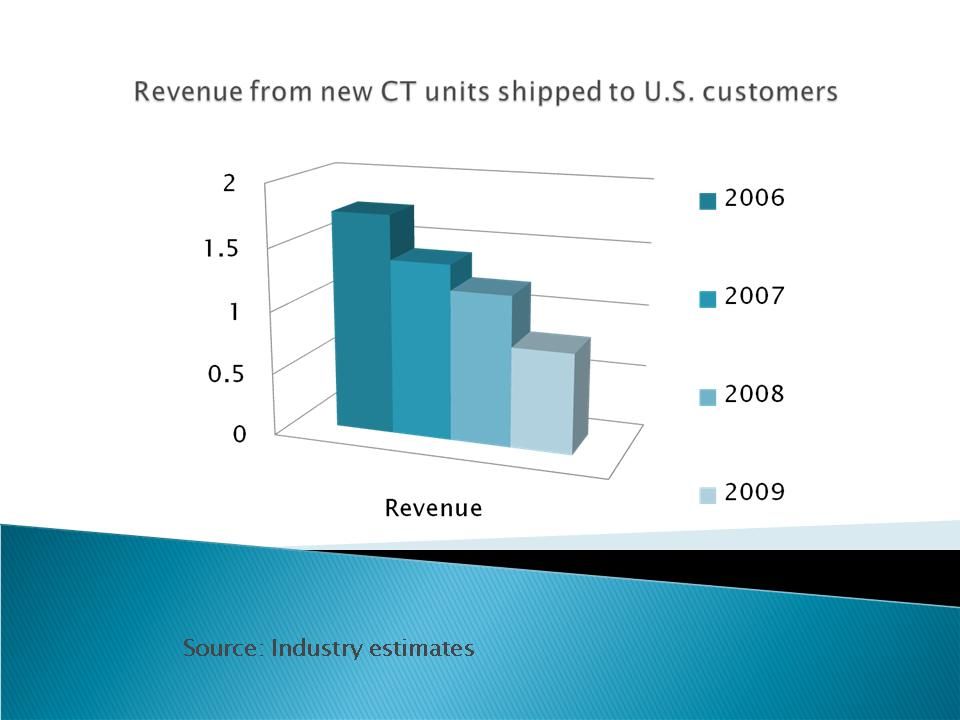Buyers market continues as demand for CT falls
Fears that revenues last year from the sale of new CTs in the U.S. would slide to levels not seen in a long time proved to be well founded, as the industry suffered its worst year in more than a decade.
Fears that revenues last year from the sale of new CTs in the U.S. would slide to levels not seen in a long time proved to be well founded, as the industry suffered its worst year in more than a decade.
U.S. sales of CT scanners last year totaled less than $790 million, a remarkably poor showing for an industry that only three years earlier recorded new revenues of $1.75 billion from systems shipped to U.S. customers.
Industry consensus numbers indicate a 33% fall in new unit revenues in 2009 compared with the previous year and a 25% drop in the number of units sold. The disparity between revenues and units indicates softening prices, as weak demand leads vendors to price systems aggressively, which is good news for those in the market to buy new CTs.
Last year’s dismal showing comes on the heels of similarly poor sales years beginning with a steep decline in 2007, when vendors realized just $1.4 billion in new unit sales in the U.S., down 20% from the all-time high of the previous year. The decline continued in 2008, as the sale of new CT units in the U.S. dipped to $1.2 billion.
Changes in reimbursement for CT procedures and saturation of demand for 64-slice devices prompted the decline three years ago. The fall accelerated with continuing reimbursement cuts and a declining overall economy. Most signi¬ficant, this trend in downward revenues may now have fundamentally changed the marketplace.
Since the introduction of multidetector CTs in the late 1990s, the CT market had surged forward with the release of each successive generation of CT scanners: quad to 16, 16 to 64. This model of upward surges, with the greatest surge accompanying the launch of 64-slice scanners, has not held for the latest generation of CTs comprising 256- (and more) slice scanners.
Although vendors have tried, with some success, to position the current generation of superpremium systems as general-purpose radiological scanners, their efforts have mostly fallen short. The power of these products is best realized in subspecialty applications, namely those involving brain perfusion, such as stroke diagnosis and cardiac imaging.
One reason for the scant support shown these CT scanners has been their stratospheric prices, all above $1.5 million, which are bound to hurt their chances in the midst of a global recession. As a result, the market has turned from the decade-old stair-step growth model, defined by periodic surges in new product sales, to a bell-shaped curve shaped by sales of midtier products. The once top-of-the-line but now midtier 64- and 128-slice CT scanners last year accounted for the majority of demand, according to a consensus of industry executives.
The current CT business model, therefore, appears to reflect one seen among high-priced U.S. consumer products such as cars, whereby midtier models attract most of the interest, with lower tier and luxury models accounting for less.
Industry executives recognize this change in business models and expect it to continue into the foreseeable future.

Could AI-Powered Abbreviated MRI Reinvent Detection for Structural Abnormalities of the Knee?
April 24th 2025Employing deep learning image reconstruction, parallel imaging and multi-slice acceleration in a sub-five-minute 3T knee MRI, researchers noted 100 percent sensitivity and 99 percent specificity for anterior cruciate ligament (ACL) tears.
Meta-Analysis Shows Merits of AI with CTA Detection of Coronary Artery Stenosis and Calcified Plaque
April 16th 2025Artificial intelligence demonstrated higher AUC, sensitivity, and specificity than radiologists for detecting coronary artery stenosis > 50 percent on computed tomography angiography (CTA), according to a new 17-study meta-analysis.
Can CT-Based AI Radiomics Enhance Prediction of Recurrence-Free Survival for Non-Metastatic ccRCC?
April 14th 2025In comparison to a model based on clinicopathological risk factors, a CT radiomics-based machine learning model offered greater than a 10 percent higher AUC for predicting five-year recurrence-free survival in patients with non-metastatic clear cell renal cell carcinoma (ccRCC).